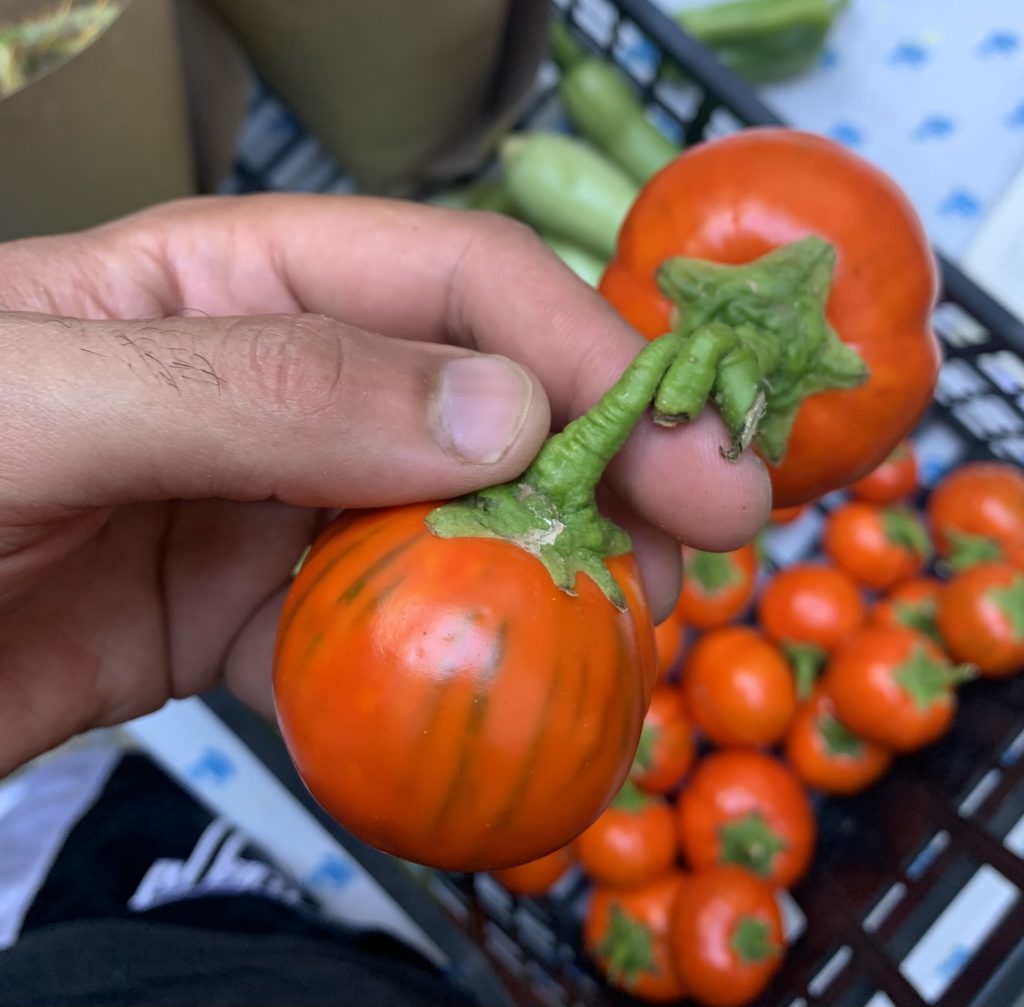Excerpt from a talk held by Fabio Aranzulla and Luca Cinquemani in Palermo on 4 June 2022
In the last few months the Aterraterra collective has been dealing with the problematic and often colonial origins of many food plants. Today we want to tell you the story of Solanum Aethiopicum. We received seeds of this plant from a friend, who thought it would be interesting to let us have them. At the time we knew almost nothing about this plant, we had seen it before but did not know its history. The package said “Rotonda red eggplant.” The name used in Italy does not tell us much about the plant’s colonial origin, while the scientific name, Solanum Aethiopicum, tells us about its Ethiopian origins.
Let’s start from the description we find on the website of Slow Food – a nonprofit foundation that focuses on enhancing local productions, especially related to the local area, small-scale production, and local excellence – of this eggplant and analyze parts of this text together, since they are particularly problematic.
Slow Food: ”It is small and round like an apple, bright orange in colour with green and reddish streaks: the fruits resemble tomatoes or persimmons more than eggplants. It is no accident that in the local language it is called “merlingiana a pummadora.” The Rotonda red eggplant (Solanum aethiopicum) is a distant relative of the common eggplant (Solanum melongena) that arrived in Europe perhaps from India and that has got bright violet berries. The Rotonda eggplant arrived by the end of the nineteenth century, probably from Africa, maybe imported by some soldiers coming back from colonial wars.Unknown elsewhere, it is a rustic plant cultivated in every Rotonda garden and it has got a more bitter and exotic taste compared to the normal eggplants. The small plants are bedded out in May and the first harvest takes place in August and it continues until cold weather sets in. There are also peculiar methods for preservation: the small eggplants are “nzertate”, that is tied up in bunches like peppers and small tomatoes and left to dry under roofing.It is eaten in oil or in vinegar, hardly ever just picked; also leaves are appreciated, they are soft and different in size and shape from those of the ordinary eggplant. Their pulp is fleshy and retains its creamy colour even hours after being cut; the aroma is fruity and intense, reminiscent of prickly pears; the flavour is spicy with a pleasantly bitter finish.The “African” red eggplant is only one of the vegetables that make Rotonda (3,000 people, about 600 metres high, fifty kilometres from Maratea sea) a small capital city for traditional horticulture, embedded in a unique environmental context: the Pollino National Park, the largest protected area of our country. Its peculiarity is the low content in chlorogenic acid responsible for darkening the flesh in other eggplants: this aspect makes it ideal for processing and preservation.”

The first issue that jumps out is certainly the very brief, only mentioned narrative of the colonial origins of the Rotonda red eggplant. It is said that it is most likely related to Italian colonialism. In fact, we began researching and interviewing people living in Rotonda, understanding that the story is much more complex than how it is told. The story says that the red eggplant arrived in Basilicata with soldiers returning from Ethiopia during the first phase of Italian colonialism. Angelo Passalacqua, a great seed conservator, told us that the cultivation of the red eggplant in Rotonda was also linked to particular conditions of these soldiers: it was the plant of poverty. Those who grew Solanum Aethiopicum were always former soldiers living in poverty. Its cultivation and consumption somehow represented a stigma.
This narrative is interrupted when Slow Food attempts to re-brand the Rotonda red eggplant by first enacting a simplification of its colonial history, then devoting only a few lines to this concept. The foundation also uses an interesting term in this narrative, namely calling the red eggplant “exotic.” In the text we read that the eggplant is unknown “elsewhere” implying that Italy is somewhat the center of the world: the red eggplant is actually cultivated and used in so many parts of the world, for example in Nigeria and parts of India.
What does exotic mean? The term exotic is used to make a distinction between “us” and “others,” between what is known and what is not known. Having come to this point, we ask ourselves: when does something become exotic or when does it stop being exotic? Why don’t we think about tomatoes, which also have a colonial history behind them, as a fruit with an exotic flavor? We realized, finally, that this is an exemplary case of Italianization: both the tomato and the Rotonda red eggplant, are Italianized, then slowly assimilated and, over time, stop being considered exotic. Clearly, Slow Food talks about exoticism to make the red eggplant of Rotonda more appealing. As we see, food plant narratives reflect the colonial framework that is within our cultural and social language and patterns.
Finally, Slow Food writes in a small note that “collected knowledge belongs to the communities that have preserved it over time.” This allows us to make a connection with the issue of restitution. The question is: to whom does this knowledge belong? And who has preserved it over time in this case? Slow Food is making this red eggplant a narrative linked to the territory of Rotonda. How should we deal with such a case? Stop growing it or continue growing it while trying to renew its narrative? How can we imagine restitution in the case of plants, which by their definition are constantly moving and changing?
Picture: Solanum Aethiopicum or Rotonda red eggplant
